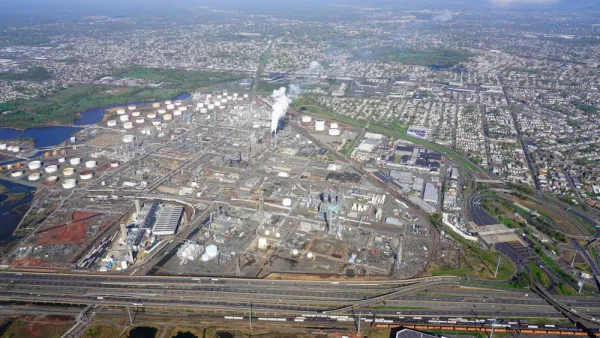Nine Mid-Atlantic and Northeast states and the District of Columbia have agreed to work together to develop a policy to price emissions from transportation, set a 'cap' on them, and invest the revenues in low carbon transportation solutions.

Connecticut, Delaware, Maryland, Massachusetts, New Jersey, Pennsylvania, Rhode Island, Vermont, Virginia, and District of Columbia belong to the Transportation and Climate Initiative (TCI), a regional collaboration that formed in 2010 to improve transportation, develop the clean energy economy and reduce carbon emissions from the transportation sector, the largest source of emissions in most of these states as well as the nation.
According to the initiative statement [pdf] signed Dec. 18, "the participating TCI jurisdictions will design a regional low-carbon transportation policy proposal that would cap and reduce carbon emissions from the combustion of transportation fuels through a cap-and-invest program or other pricing mechanism, and allow each TCI jurisdiction to invest proceeds from the program into low-carbon and more resilient transportation infrastructure."
The participating TCI jurisdictions plan to complete the policy development process within one year, after which each jurisdiction will decide whether to adopt and implement the policy
Fuel distributors in the nine states and D.C. will be required "to buy pollution permits [or allowances] for some of the carbon they produce," writes David Abel, environmental reporter for the Globe.
"We estimate that at modest allowance prices that would cost the average driver $6 per month, the program could bring approximately $3.5 billion into the region for clean transportation investments," writes Ken Kimmel, president of the Union of Concerned Scientists.
While there are a number of policies in place to lower transportation emissions (fuel economy standards for cars and trucks, incentives and mandates for electric cars, and investments in public transit), transportation sector emissions are expected to stay flat, and may even rise.
Why? Among other things, we are missing two key pieces: 1) a legally binding mechanism to force overall emissions down; and 2) a revenue source to fund the transition to cleaner transportation.
"If approved, the agreement would be modeled after the Regional Greenhouse Gas Initiative, a nine-state regional “cap-and-invest” system for power plant emissions known as RGGI," adds Abel.
Widely seen as a national model, the mandatory market-based program has helped reduce power plant emissions from Maryland to Maine by about 40 percent below 2005 levels without raising average electricity prices.
All but Pennsylvania, New Jersey, Virginia and D.C. are RGGI members, though Gov. Tom Murphy (D-N.J.) announced on Monday that "the Department of Environmental Protection has formally proposed two rules that will steer New Jersey’s re-entry into the Regional Greenhouse Gas Initiative."
RGGI members New Hampshire, New York, and Maine have not signed, although New York and Maine are expected to. It is unclear why New York has not signed yet, but Maine is expected to join the coalition after its newly elected governor, Janet Mills, takes office next month.
Fuel allowance revenues would be spent for a variety of low carbon transportation programs that would be selected by each jurisdiction, "including public transit, carpooling and driverless car services, subsidies to accelerate the adoption of electric vehicles, and new bike lanes," notes Abel.
TCI is facilitated by the nonpartisan Georgetown Climate Center, part of Georgetown Law.
Additional reading:
- Utility Dive, Dec. 18: "Regional initiative to reduce transportation emissions would mirror RGGI."
- TCI press release: "Nine States and D.C. to Design Regional Approach to Cap Greenhouse Gas Pollution from Transportation."
- NJ Department of Environmental Protection news release: "New Jersey to Participate in Design of Regional Approach to Reduce Greenhouse Gas Emissions trom Transportation Sector."
FULL STORY: In landmark agreement, Mass., eight other states vow to cut transportation emissions

Analysis: Cybertruck Fatality Rate Far Exceeds That of Ford Pinto
The Tesla Cybertruck was recalled seven times last year.

National Parks Layoffs Will Cause Communities to Lose Billions
Thousands of essential park workers were laid off this week, just before the busy spring break season.

Retro-silient?: America’s First “Eco-burb,” The Woodlands Turns 50
A master-planned community north of Houston offers lessons on green infrastructure and resilient design, but falls short of its founder’s lofty affordability and walkability goals.

Test News Post 1
This is a summary

Analysis: Cybertruck Fatality Rate Far Exceeds That of Ford Pinto
The Tesla Cybertruck was recalled seven times last year.

Test News Headline 46
Test for the image on the front page.
Urban Design for Planners 1: Software Tools
This six-course series explores essential urban design concepts using open source software and equips planners with the tools they need to participate fully in the urban design process.
Planning for Universal Design
Learn the tools for implementing Universal Design in planning regulations.
EMC Planning Group, Inc.
Planetizen
Planetizen
Mpact (formerly Rail~Volution)
Great Falls Development Authority, Inc.
HUDs Office of Policy Development and Research
NYU Wagner Graduate School of Public Service




























